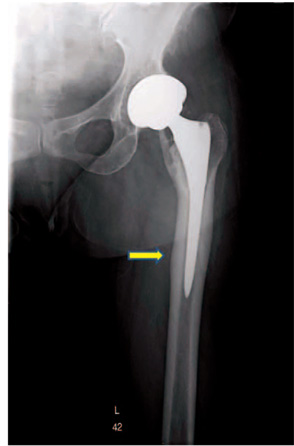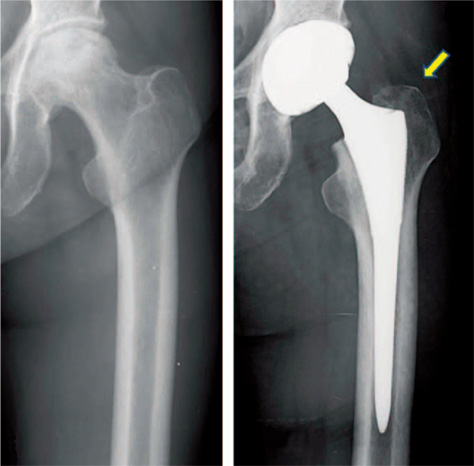Hip Pelvis.
2017 Dec;29(4):228-233. 10.5371/hp.2017.29.4.228.
Primary Total Hip Arthroplasty Using Summit® Stems in Korean: Minimum Four-year Follow-up
- Affiliations
-
- 1Department of Orthopedic Surgery, Inha University College of Medicine, Incheon, Korea. moon@inha.ac.kr
- KMID: 2424248
- DOI: http://doi.org/10.5371/hp.2017.29.4.228
Abstract
- PURPOSE
The aim of this study was to assess the mid-term results of primary cementless total hip arthroplasty (THA) using Summit® stems.
MATERIALS AND METHODS
One hundred twenty-eight arthroplasties in 121 patients who were performed THA from December 2004 to March 2013, were reviewed retrospectively a minimum of 4 years follow-up (mean age, 60.3 years; mean postoperative follow up period, 86.3 months). For a clinical evaluation, the Harris hip score (HHS) was used to assess outcome. Radiographic evaluation was done through spot welds, subsidence, stress shielding, canal filling.
RESULTS
The mean HHS was 69.8 points preoperatively, and it improved significantly to 96.3 points at the final follow-up. Postoperatively, 10 patients experienced thigh pain and 7 patients showed a moderate limping gait. There was not only early stem subsidence but there was no more subsidence at last follow up. One hundred eighteen hips showed radiographic signs of stem bone ingrowth, and 10 hips showed fibrous ingrowth at the last follow-up. Stress shielding occurred in 85 hips and third degree stress shielding was observed in 6 hips. Complication arose in 10 hips due to dislocation. Although revisions due to recurrent dislocations led to acetabular component revision in one hip, no revisions arose due to isolated aseptic loosening of the femoral component.
CONCLUSION
The clinical and radiological mid-term results of primary THA using Summit® stems revealed solid initial fixation and bone ingrowth stable fixation. Considering the satisfactory clinical results, Summit® stems may be a good treatment option in Korean patients who were required hip arthroplasty
Keyword
MeSH Terms
Figure
Reference
-
1. Burnett RSJ. Total hip arthroplasty: Techniques and results. B C Med J. 2010; 52:455–464.2. Engh CA, Massin P. Cementless total hip arthroplasty using the anatomic medullary locking stem. Results using a survivorship analysis. Clin Orthop Relat Res. 1989; (249):141–158.3. Oh KJ, Lee JG. Usefulness of a modular hip system for combined anteversion in cementless total hip arthroplasty. Hip Pelvis. 2013; 25:30–36.
Article4. Dorr LD, Faugere MC, Mackel AM, Gruen TA, Bognar B, Malluche HH. Structural and cellular assessment of bone quality of proximal femur. Bone. 1993; 14:231–242.
Article5. Nishino T, Mishima H, Miyakawa S, Kawamura H, Ochiai N. Midterm results of the Synergy cementless tapered stem: stress shielding and bone quality. J Orthop Sci. 2008; 13:498–503.
Article6. Callaghan JJ, Salvati EA, Pellicci PM, Wilson PD Jr, Ranawat CS. Results of revision for mechanical failure after cemented total hip replacement, 1979 to 1982. A two to five-year followup. J Bone Joint Surg Am. 1985; 67:1074–1085.
Article7. Harris WH. Traumatic arthritis of the hip after dislocation and acetabular fractures: treatment by mold arthroplasty. An end-result study using a new method of result evaluation. J Bone Joint Surg Am. 1969; 51:737–755.
Article8. Sakai T, Sugano N, Nishii T, Haraguchi K, Ochi T, Ohzono K. Stem length and canal filling in uncemented custom-made total hip arthroplasty. Int Orthop. 1999; 23:219–223.
Article9. Kim YH, Kim VE. Uncemented porous-coated anatomic total hip replacement. Results at six years in a consecutive series. J Bone Joint Surg Br. 1993; 75:6–13.
Article10. Mulliken BD, Bourne RB, Rorabeck CH, Nayak N. A tapered titanium femoral stem inserted without cement in a total hip arthroplasty. Radiographic evaluation and stability. J Bone Joint Surg Am. 1996; 78:1214–1225.
Article11. Gruen TA, McNeice GM, Amstutz HC. “Modes of failure” of cemented stem-type femoral components: a radiographic analysis of loosening. Clin Orthop Relat Res. 1979; (141):17–27.12. Engh CA, Glassman AH, Suthers KE. The case for porous-coated hip implants. The femoral side. Clin Orthop Relat Res. 1990; (261):63–81.13. Yang IH, Park SH, Han CD. Cementless total hip arthroplasty using ceramic-on-ceramic summit(R) system: 3 years follow up. J Korean Hip Soc. 2007; 19:9–15.
Article14. Lim YW, Lee KH, Bae SH, Kwon SY. Comparative analysis of two cementless stems in total hip arthroplasties in patients with osteonecrosis of femoral head: summit(R) stem and bencox(R) stem. J Korean Hip Soc. 2012; 24:25–31.
Article15. Engh CA, Bobyn JD. The influence of stem size and extent of porous coating on femoral bone resorption after primary cementless hip arthroplasty. Clin Orthop Relat Res. 1988; (231):7–28.
Article16. Noble PC, Alexander JW, Lindahl LJ, Yew DT, Granberry WM, Tullos HS. The anatomic basis of femoral component design. Clin Orthop Relat Res. 1988; (235):148–165.
Article17. García-Cimbrelo E, Bru-Pomer A, García-Benítez B, Hernández-Blanco M, Vaquero J. Multicentric and prospective study of the Summit cementless stem. Hip Int. 2010; 20(Suppl 7):S63–S69.
Article18. Engh CA, Bobyn JD, Glassman AH. Porous-coated hip replacement. The factors governing bone ingrowth, stress shielding, and clinical results. J Bone Joint Surg Br. 1987; 69:45–55.
Article
- Full Text Links
- Actions
-
Cited
- CITED
-
- Close
- Share
- Similar articles
-
- Cementless Total Hip Arthroplasty with Circumferentially Proximal Porous-Coated Femoral Stem -Minimum 10-Year Follow-up Results
- Primary Total Hip Arthroplasty Using Third Generation Ceramic-Ceramic Articulation: Results after a Minimum of Three-years of Follow-up
- Clinical and Functional Outcomes of the Exeter V40 Short Stem in Primary and Revision Arthroplasty: Does the Indication Affect Outcomes in the Short Term?
- Comparative Analysis of Two Cementless Stems in Total Hip Arthroplasties in Patients with Osteonecrosis of Femoral Head: Summit(R) Stem and Bencox(R) Stem
- Comparison of Short Curved Stems and Standard-length Single Wedged Stems for Cementless Total Hip Arthroplasty




